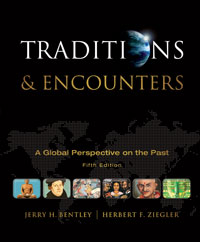 
Traditions and Encounters, AP Edition (Bentley), 5th EditionChapter 16:
The Two Worlds of ChristendomChapter Outline- The quest for political order
- The Early Byzantine Empire
- The City of Constantine
- Caesaropapism
- Justinian (527-565 C.E.) and his legacy; Theodora (empress)
- Rebuilt Constantinople, including Hagia Sophia
- Justine's Code
- Codified Roman law Corpus iuris civilis (The Body of the Civil Law)
- Byzantine Conquests
- Muslim Conquests and Byzantine Revival
- Muslim Conquests
- The Theme system
- The Rise of the Franks
- Germanic Kingdoms
- The Franks
- Charlemagne (reigned 768-814 C.E.)
- Grandson of Charles Martel, founder of Carolingian empire
- Control extended to northeast Spain, Bavaria, north Italy
- Charlemagne's Administration
- Capital city at Aachen (in modern Germany)
- Relied on aristocratic deputies, known as counts
- Used missi dominici to oversee local authorities
- Charlemagne as Emperor
- Pope Leo III proclaimed Charlemagne emperor, 800
- The coronation strained relations with Byzantine emperors
- The Age of the Vikings
- Louis the Pious
- Invasions
- Vikings
- Devolution of Political Authority
- Economy and Society in Early Medieval Europe
- The Two Economies of Early Medieval Europe
- Byzantine Peasantry
- Manufacturing
- Silk
- Agriculture production suffered from repeated invasions
- Heavy plows
- Heavy plows appeared in the sixth century; could turn heavy northern soils
- Became common from the eighth century; production increased
- Cultivation of new lands; watermills; and rotating crops
- Rural society--agricultural surplus not enough to support large cities
- Mediterranean trade--Italian and Spanish merchants trade with Muslims
- Norse merchant mariners in North and Baltic Seas
- Followed routes of Vikings
- Traded actively with Byzantine and Abbasid empires
- Imported Abbasid silver used in European coinage
- Population: 36 million in 200; down to 26 million in 600; back up to 36 million in 1000
- Social Development in the Two Worlds of Christendom
- Byzantium: An Urban Society
- City Life
- Attractions of Constantinople
- Western Europe: A Rural Society
- The Question of Fudalism
- Peasants
- Population
- The Evolution of Christian Societies in Byzantium and Western Europe
- Popes and Patriarchs
- The Papacy
- Pope Gregory I
- Organized defense of Rome against Lombard's' menace
- Reasserted papal primacy over other bishops
- Strongly emphasized the sacrament of penance--confession and atonement
- The Patriarchs
- Iconoclasm
- Monks and Missionaries
- Asceticism
- Devout Christians practiced asceticism in deserts of Egypt, second and third century
- Monastic lifestyle became popular when Christianity became legal, fourth century
- St. Basil and St. Benedict
- St. Basil of Caesarea (329-379 C.E.) organized monastic movement
- St. Benedict (480-547 C.E.) provided a set of regulations
- Virtues of Benedictine monks: poverty, chastity, and obedience
- St. Scholastica
- St. Benedict's sister, a nun
- Adapted the Rule, and provided guidance for religious life of women
- Monasticism and Society
- Became dominant feature in social and cultural life of western Europe
- Accumulated large landholdings
- Organized much of the rural labor force for agricultural production
- Provided variety of social services: inns, shelters, orphanages, hospitals, schools
- Libraries and scriptoria became centers of learning.
- Missionaries
- Two Churches
- Religious Rivalry
- Constantinople and Rome: strains mirrored political tensions
- Ritual and doctrinal differences, such as iconoclasm
- Schism
- Schism in 1054--Eastern Orthodox versus Roman Catholic
 |  |
|





